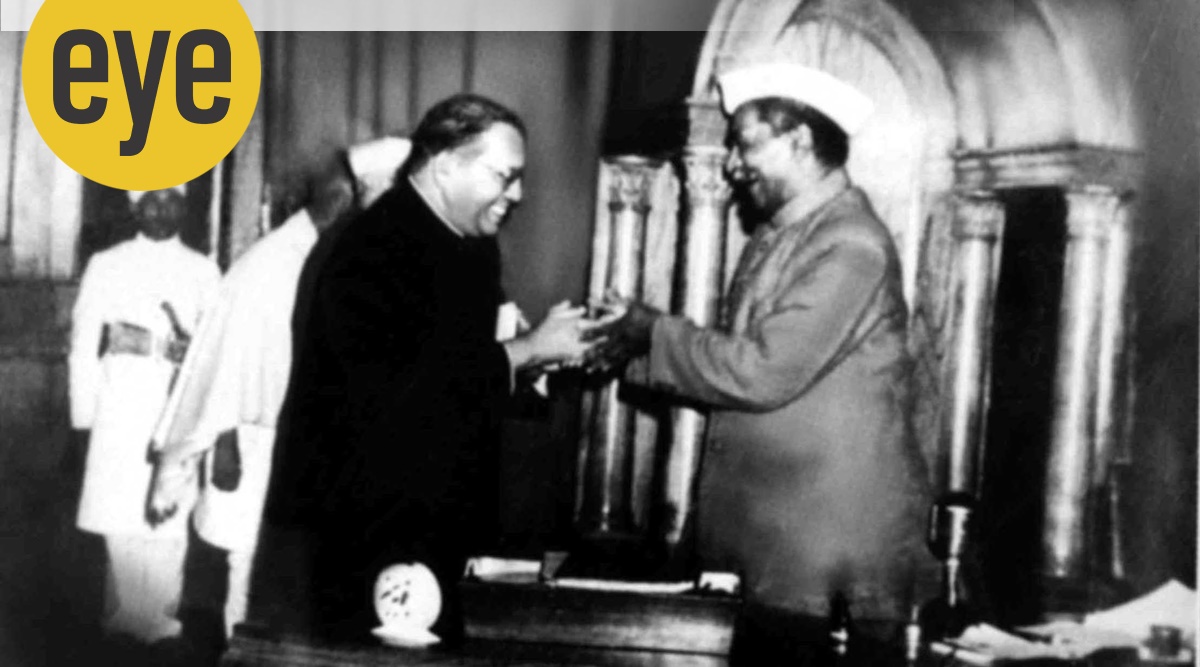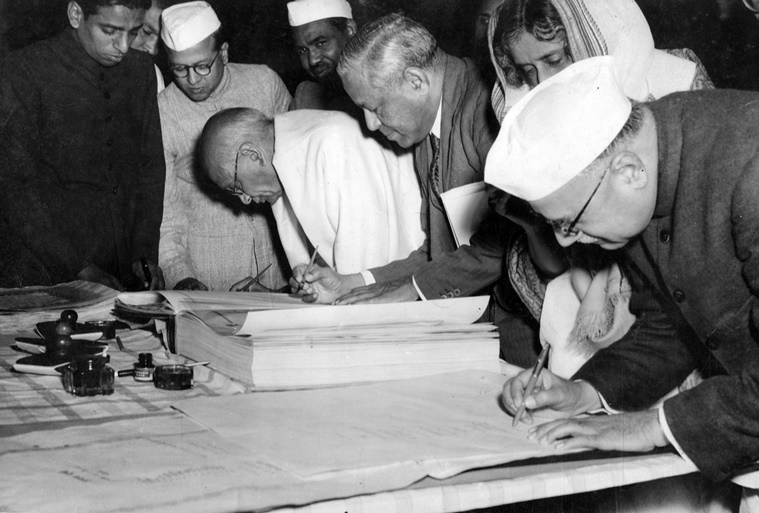 BR Ambedkar (left) presenting the final draft of the Constitution to Dr Rajendra Prasad on November 25, 1949 (Photo: Express archive)
BR Ambedkar (left) presenting the final draft of the Constitution to Dr Rajendra Prasad on November 25, 1949 (Photo: Express archive) Space entrepreneur Elon Musk would have loved Constituent Assembly members HV Kamath and Naziruddin Ahmad. Both of them flagged the issue of interplanetary travel during the drafting of the Constitution. On August 31, 1949, the Constituent Assembly was discussing the subjects to be included in the Union List, legislating on which would fall exclusively in the domain of the central government.
Kamath suggested including interplanetary travel in the Union List. His colleagues laughed at his amendment, but Kamath pressed on. He reasoned, “I dare say, when the earth becomes more and more populated and congested, and when science makes further advance, people may start colonising the moon or some of the other thinly populated planets of the solar system.” The Assembly rejected the amendments of both Kamath and Ahmad.
It took the Constituent Assembly almost three years to draft the Constitution. Partly because its members submitted around 7,600 amendments to the draft Constitution. Of these, around 2,400 were moved on the Assembly floor by Kamath, professor KT Shah, Shibban Lal Saxena and Pandit Hirday Nath Kunzru, among others. Most of these did not make it into the Constitution. Some because the suggestion couldn’t bring the members together on matters like calling the country the United States of India or the Union of Indian Socialistic Republics. Others because the Assembly and Parliament didn’t realise the gravity of their actions.
Two current issues resonated during the framing of the Constitution and its subsequent amendment. The Constitution gives the government the power to convene the legislature. It was similar to a provision before Independence. During the debate in the Constituent Assembly, BR Ambedkar argued that under colonial rule, the purpose of this provision was to summon the legislature only to collect revenue and prevent it from scrutinising the government. Some members were apprehensive that the framing of the constitutional article might result in the legislature not being convened enough.
 (From left) Members of the Constituent Assembly, including Sardar Vallabhbhai Patel, Rajkumari Amrit Kaur and Jairamdas Daulatram signing copies of the Constitution, ahead of the Republic Day, in 1950. (Photo: Express archive)
(From left) Members of the Constituent Assembly, including Sardar Vallabhbhai Patel, Rajkumari Amrit Kaur and Jairamdas Daulatram signing copies of the Constitution, ahead of the Republic Day, in 1950. (Photo: Express archive) Ambedkar had replied, “We thought, and personally, I also think, that the atmosphere has completely changed and I do not think any executive would hereafter be capable of showing this kind of callous conduct towards the legislature.” Shah thought that Parliament should sit throughout the year, with breaks in between. Others wanted Parliament to sit for longer durations and gave examples of the British and American legislatures meeting for more than a hundred days in a year. Shah also wanted the presiding officers of the two Houses to be empowered to convene Parliament in certain circumstances. But these suggestions were not accepted by the Constituent Assembly. Last year, our Parliament met for 59 days. Governors convene legislatures in states on the same lines as Parliament. In its five-year term, the outgoing Vidhan Sabha in Uttar Pradesh, the largest in the country, met for an average of 21 days and Punjab averaged 16 days.
In poll-bound states, the issue of defections can’t be far behind. In 1985, the Parliament amended the Constitution to prevent political defections. The statement of purpose of the amendment bill stated, “The evil of political defections has been a matter of national concern. If it is not combated, it is likely to undermine the very foundations of our democracy and the principles which sustain it.”
The amendment penalised individual MPs/MLAs from changing political parties after election, by expelling them from the legislature. But if one-third banded together to join another party, they would be protected. The amendment also shielded two-thirds of MPs/MLAs from merging with another party. It also made the Speaker of the legislature the deciding authority on defections.
During a Parliament debate in 1985, MPs like the socialist leader Madhu Dandavate expressed concern over the impact the amendment could have on the office of the Speaker. In 1987, a few years after the passing of the amendment to prevent defections, Goa became a state. The one-third split provision and the partisan conduct of Goa Speakers led to 10 changes in government over 12 years. Seven of these governments lasted only for two years.
Then Parliament amended the Constitution in 2003 and removed the split provision, but the merger clause remained. While debating the amendment, MPs argued for the deletion of the merger provision. One said, “merger is a hiatus and a respectable name for defection.” But their suggestions had no impact. In the outgoing Goa assembly (2017-22), using the provision, two-third of the Congress MLAs merged with the ruling BJP. In another poll-bound state, Manipur, the conduct of the Speaker in deciding defection has invited criticism from the Supreme Court.
The late American Supreme Court Justice Antonin Scalia had once said, “When history demonstrates that one of the Court’s decisions has been a truly horrendous mistake, it is comforting… to look back and realise that at least some of the Justices saw the danger clearly and gave voice, often eloquent voice, to their concern.” His observation is accurate in the context of our constitutional history.
There is some consolation that our Constitution framers and, later, Members of Parliament identified and high-lighted the concerns in our founding document. The question is, in the 73rd year of our Constitution, how many of those will we rectify?
Chakshu Roy and Jayraj Pandya are with PRS Legislative Research
- The Indian Express website has been rated GREEN for its credibility and trustworthiness by Newsguard, a global service that rates news sources for their journalistic standards.

